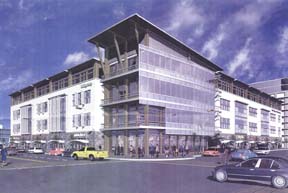 |
||||||||
| FEATURE ARTICLES | Memo Calendar | Memo Pad | Business Memos | Loaves & Fishes | Letters | Home | ||
LEE PERLMAN
THE MID-COUNTY MEMO
“Have dreams, big dreams, and hold onto them, but keep your feet firmly on the ground. Remember that there are no short cuts, free rides or sure things”
- Ralph Bunch
Bunch’s words might well apply to developer Ted Gilbert.
 |
| Building No. 1 of The Elements at Gateway will be a four-story retail and office building. This view is from Northeast 102nd Avenue and Pacific Street. |
| SUBMITTED GRAPHIC |
Among the factors contributing to make it happen are the confluence of two freeways, two light rail lines, of which one leads directly to Portland International Airport, and lots of suitable land. Gilbert himself owns eight acres, Fred Meyer across the street owns another three acres and the nearby Gateway Elks Lodge sits on five more acres. The PacTrust property encompasses 32 acres.
“There’s a decade worth of projects here, millions of square feet,” said Gilbert. “Whether it was good planning or divine intervention, it all came together at Gateway. I couldn’t duplicate this anywhere else in the region if I tried. This is a once in a lifetime opportunity.”
So why does his first project include a huge surface parking lot, the very thing the Opportunity Gateway vision seeks to eliminate?
His original plans, Gilbert said, called for a six story building on the site with structured parking, two restaurants, and a public plaza with a fountain. However, he said, “It became obvious this wouldn’t pencil if done in today’s market.” As for public funding assistance, he says, “Most of the available tax increment funds (generated by the Gateway urban renewal district) have been allocated to the Oregon Clinic.” This is part of a development planned for part of the Gateway Transit Center parking lot. “The district will be short of funds for five years.
“So we redesigned the project,” Gilbert said. The first building will be four stories high and contain 114,000 square feet, most of it Class A office space, but including 39,000 square feet of retail. The cost will be $21 million.
“Pre-leasing is going pretty well,” Gilbert said. As potential tenants who have expressed interest he mentioned “premier” coffee shops and ice cream parlors, a restaurant, bank and hair salon, as well as medical offices,
“A letter of interest is just that, but based on that, we’re halfway done,” he said. “Our lenders have told us they’d be prepared to go with 50 percent of the space pre-leased. We’re doing a feasibility study, and we have better retail demographics here than Clackamas Town Center or Tannesbourne Mall, and almost as good as (Tualatin’s) Bridgeport Village.” He added, “We haven’t abandoned our vision. If the market turns out to be good as what our gut tells us, we could start the next building as soon as the first one is finished.” Gilbert hopes to build on the new surface lot, and to eventually have 675,000 square feet of office space, 118,000 square feet of retail, and 600 to 800 housing units. “We want a broad range of housing types,” he told Hazelwood’s Bob Ernst. These would include “empty nesters and airport workers.”
Gilbert’s first moves earned him some embarrassment. The Gateway Apartments, home to low-income households, occupied the land and when Gilbert sought to evict them, they and the Community Alliance of Tenants fought back. The matter twice came before the Portland City Council, where CAT organizers portrayed the issue as one of displacement of the poor for the sake of the rich. The two sides eventually reached an accommodation.
Gilbert claimed that when he bought the property the apartments were already beyond redemption. “When they wanted to show urban blight, they took pictures of our property,” he said.
The first project will incorporate “green building” practices, and will use large beams from old growth trees salvaged from the demolition of the historic Sellwood trolley barns. He hopes to make Northeast Pacific Street a “green street.”
Gilbert also hopes his efforts will be a catalyst for others, notably Fred Meyer. He quoted current Fred Meyer management as saying of their vacant property, “nothing will happen here for 50 years.”
“If we get them excited by what we do, they could redevelop in the near term,” Gilbert said. Despite his enthusiasm, Gilbert admitted he is facing major challenges. “Steel prices have gone up dramatically,” he told an Opportunity Gateway committee. The price of “anything involving oil has gone up big time.” He complained that the city is allowing him to have just three off-street parking spaces per 1,000 square feet after allowing four per 1,000 at CascadeStation. On-street parking would be possible only if he donated land to the purpose, which he cannot afford to do. He fears that delays could cause potential tenants to leave.
“We need all the help we can get,” he admitted.
One asset he does have is the good will of his neighbors. Gayland German of Hazelwood was at first leery because he thought Gilbert would be seeking urban renewal funds. “We won’t take a dime of public funds,” Gilbert reassured him. “This creates funds for improvements in your community. When the urban renewal district ends, it will help pay for schools and police.” Hazelwood Neighborhood Association Chairwoman Arlene Kimura told Gilbert, “I hope you can pull this off.” Barbara Harrison, another Hazelwood Neighborhood Association board member, said, “I’m so happy to see something finally happening there.”
Beth Baltz of Portland Adventist Medical Center and the Opportunity Gateway Program Advisory Committee board told Gilbert with regard to parking, “If you have something really good, people will find a way to get there.”
 |
 |
 |
MEMO Advertising | MEMO Archives | MEMO Web Neighbors | MEMO Staff | Home